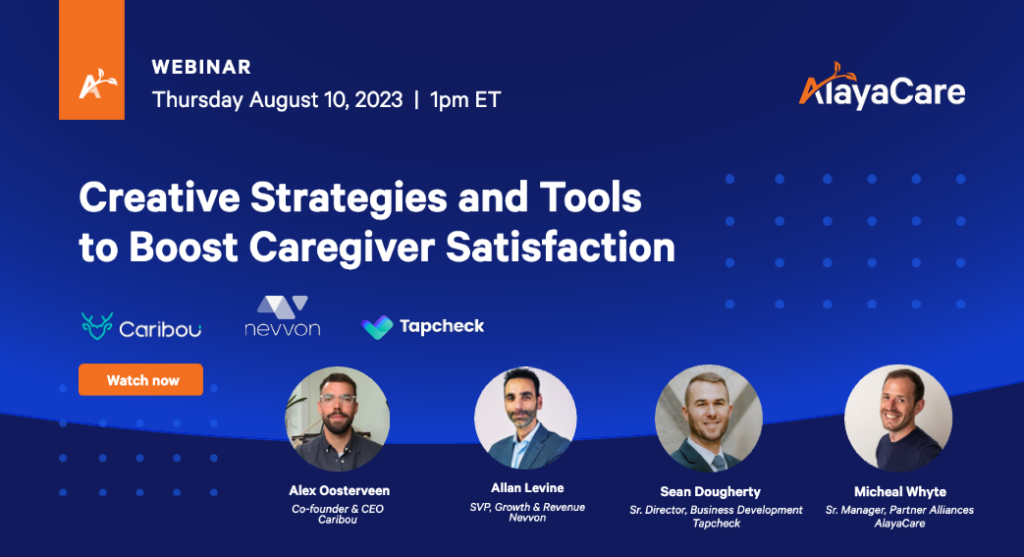Blog
Creative strategies and tools to boost caregiver satisfaction [Webinar Recap]

The home-based care workforce will have 4.7 million total job openings by 2030, 3.7 million of which were vacated by caregivers moving into other occupations or leaving the labor force altogether. As the senior population continues to skyrocket, projected to triple over the next two decades, it’s vital to embrace tactics that can revitalize caregiver satisfaction and retain workers for the long term.
During a recent webinar with partners in our AlayaSphere, our Sr. Manager of Partner Alliances, Michael Whyte, brought together Alex Oosterveen, Co-founder and CEO of Caribou Rewards; Allan Levine, SVP of Growth & Revenue at Nevvon training, surveying, and mentorship company; and Sean Dougherty, Sr. Director of Business Development at Tapcheck, the earned age access platform to discuss the current state of caregiver satisfaction alongside actionable strategies to improve it.
Take a look at the top recommendations from the roundtable discussion and watch along here.
Inquire about emerging needs
As per a 2022 PHI report on direct care workers, the home-based care workforce is one of the largest and fastest-growing occupations in North America. However, with this extreme growth a vast array of diverse caregiver preferences has emerged that has given way to a haul of unsatisfied needs.
“There’s no better driver to figure out what your caregivers want and need than to ask and track answers over time,” explains Allan LeVine. “We’re asking things like employee morale and customer satisfaction … We’re getting that feedback for our customers, and we’re putting it on a platform that they can take action on.”
Improve scheduling cadence
“We’re seeing a lot of caregivers who are feeling unsatisfied and are maybe leaving positions because they’re not getting enough hours to satisfy their needs,” AlayaCare’s Mike Whyte explains. Nearly two in five home-based care workers work fewer than 35 hours per week, with 31% attributing their part-time hours to “non-economic reasons” that include scheduling and staffing challenges.
“We’ve been putting a lot of focus into things like our Visit Optimizer feature to ensure caregivers are happy with their schedules and are getting enough hours,” Mike adds. AlayaCare’s Visit Optimizer utilizes advanced algorithms to match caregivers with vacant visits for balanced schedules.
Include flexible payments
When paired with median hourly wages that have barely been adjusted for inflation, home care workers earn a median annual income of just $19,100. One in six currently lives below the federal poverty line and another 16% lack health insurance coverage to meet basic wellness needs. The ability to offer caregivers fluid payments can dramatically improve general satisfaction levels.
“I’ve heard firsthand from dozens of the owner-operators that we work with that they have to sometimes even head out into the field to fill up the gas tank of a caregiver because they ran out and they didn’t have any money to put in their tank to go take care of the next patient,” details Sean Dougherty.
Offering EWA, also known as on-demand pay, enables hourly workers to combat financial challenges and even absenteeism caused by a lack of personal funds. “Knowing that you could have access to wages prior to payday can help employees sleep better at night, stay current, and really, most importantly, stay focused on the most important task, which is taking care of patients,” Sean adds.
Implement recognition and growth programs
“Recognition is so important, especially coming on the other side of a pandemic,” explains Caribou’s Alex Oosterveen, who also notes that “margins are thin, and resources are limited.”
“I’d recommend just getting on a whiteboard and charting out your existing caregiver experience, from when they apply to get onboarded, hired, and stabilized at your organization. Try to make note of points where you could create a differentiated nice touch,” Alex explains. However, don’t just focus on monetary rewards—explore how you can enable caregivers to grow.
“Our customers that are doing better with retention and job satisfaction are the ones that are investing more in their training, going above and beyond what is required for compliance training,” explains Allan Levine. At a time when 94% of employees would increase retention for firms that are involved with their learning and development, consider a mentorship program.
Explore how to advance caregiver satisfaction
No workforce has experienced a trajectory quite like home-based care, which has not only doubled in size over the last decade but has also been slated to add millions of new jobs in the coming years. As the workforce continues to scale, home-based care agencies must adapt to slumps in caregiver satisfaction with the appropriate tools and strategies. Watch the webinar on-demand to learn more!


